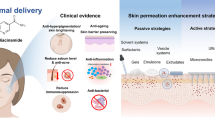Abstract
False-negative judgment due to poor chemical solubility is a problem with in vitro skin sensitisation tests. Water-insoluble chemicals are typically dissolved in DMSO in most sensitisation tests but precipitate when diluted with medium beyond their solubility in water. Such tests lack procedures to rule out false-negative judgments due to poor solubility. The IL-8 Luc assay (OECD442E) is unique in that if chemicals do not dissolve at 20 mg/mL in medium and have no effect on IL-8 luciferase activity (IL8LA), they are classified as indeterminate. The purpose of the present study was to reduce the number of indeterminate chemicals and improve assay performance. The IL-8 Luc assay can simultaneously examine glyceraldehyde 3-phosphate dehydrogenase luciferase activity (GAPLA) and IL8LA, and thus we examined the correlation between the reduction of GAPLA (defined as Inh-GAPLA) and the reduction of propidium iodide (PI)-excluding cells for three sensitizers and three non-sensitizers. We observed a significant correlation between luciferase activity driven by the GAPDH promoter of THP-G8 cells and the number of viable cells. Furthermore, chemicals providing an Inh-GAPLA value below 0.8 always reduced the ratio of PI-excluding cells to less than 0.6. Using the modified criteria, indeterminate chemicals are judged as negative if they provide Inh-GAPLA values below 0.8. This modification reduced the number of indeterminate chemicals and increased specificity, highlighting the unique advantage of the IL-8 Luc assay.




Similar content being viewed by others
Data availability
All the data are available from the corresponding author.
References
Barber RD, Harmer DW, Coleman RA, Clark BJ (2005) GAPDH as a housekeeping gene: analysis of GAPDH mRNA expression in a panel of 72 human tissues. Physiol Genomics 21(3):389–395. https://doi.org/10.1152/physiolgenomics.00025.2005
Edwards DR, Denhardt DT (1985) A study of mitochondrial and nuclear transcription with cloned cDNA probes. Changes in the relative abundance of mitochondrial transcripts after stimulation of quiescent mouse fibroblasts. Exp Cell Res 157(1):127–143
Gerberick GF, Vassallo JD, Foertsch LM, Price BB, Chaney JG, Lepoittevin JP (2007) Quantification of chemical peptide reactivity for screening contact allergens: a classification tree model approach. Toxicol Sci 97(2):417–427. https://doi.org/10.1093/toxsci/kfm064
Kim JH, Hu Y, Yongqing T et al (2016) CD1a on Langerhans cells controls inflammatory skin disease. Nat Immunol 17(10):1159–1166. https://doi.org/10.1038/ni.3523
Kimura Y, Fujimura C, Ito Y et al (2015) Optimization of the IL-8 Luc assay as an in vitro test for skin sensitization. Toxicol In Vitro 29(7):1816–1830. https://doi.org/10.1016/j.tiv.2015.07.006
Kimura Y, Watanabe M, Suzuki N et al (2018) The performance of an in vitro skin sensitisation test, IL-8 Luc assay (OECD442E), and the integrated approach with direct peptide reactive assay (DPRA). J Toxicol Sci 43(12):741–749. https://doi.org/10.2131/jts.43.741
Mori R, Wang Q, Danenberg KD, Pinski JK, Danenberg PV (2008) Both beta-actin and GAPDH are useful reference genes for normalization of quantitative RT-PCR in human FFPE tissue samples of prostate cancer. Prostate 68(14):1555–1560. https://doi.org/10.1002/pros.20815
Nakajima Y, Kimura T, Sugata K et al (2005) Multicolor luciferase assay system: one-step monitoring of multiple gene expressions with a single substrate. Biotechniques 38(6):891
Narita K, Ishii Y, Vo PTH et al (2018) Improvement of human cell line activation test (h-CLAT) using short-time exposure methods for prevention of false-negative results. J Toxicol Sci 43(3):229–240. https://doi.org/10.2131/jts.43.229
Noguchi T, Ikeda M, Ohmiya Y, Nakajima Y (2008) Simultaneous monitoring of independent gene expression patterns in two types of cocultured fibroblasts with different color-emitting luciferases. BMC Biotechnol 8:40. https://doi.org/10.1186/1472-6750-8-40
OECD (2018) OECD Test Gudeline for the Testing of Chemicals No.442E: In vitro skin sensitisation assays addressing the key event on activation of dendritic cells on the adverse outcome pathway for skin sensitisation. https://doi.org/10.1787/9789264264359-en.
Oliveira JG, Prados RZ, Guedes AC, Ferreira PC, Kroon EG (1999) The housekeeping gene glyceraldehyde-3-phosphate dehydrogenase is inappropriate as internal control in comparative studies between skin tissue and cultured skin fibroblasts using Northern blot analysis. Arch Dermatol Res 291(12):659–661
Roberts DW, Patlewicz G (2018) Non-animal assessment of skin sensitization hazard: is an integrated testing strategy needed, and if so what should be integrated? J Appl Toxicol 38(1):41–50. https://doi.org/10.1002/jat.3479
Takahashi T, Kimura Y, Saito R et al (2011) An in vitro test to screen skin sensitizers using a stable THP-1-derived IL-8 reporter cell line, THP-G8. Toxicol Sci 124(2):359–369. https://doi.org/10.1093/toxsci/kfr237
Takenouchi O, Miyazawa M, Saito K, Ashikaga T, Sakaguchi H (2013) Predictive performance of the human Cell Line Activation Test (h-CLAT) for lipophilic chemicals with high octanol-water partition coefficients. J Toxicol Sci 38(4):599–609
Thellin O, Zorzi W, Lakaye B et al (1999) Housekeeping genes as internal standards: use and limits. J Biotechnol 75(2–3):291–295
Winer J, Jung CK, Shackel I, Williams PM (1999) Development and validation of real-time quantitative reverse transcriptase-polymerase chain reaction for monitoring gene expression in cardiac myocytes in vitro. Anal Biochem 270(1):41–49. https://doi.org/10.1006/abio.1999.4085
Funding
This study was supported by Grants-in-Aid from the Ministry of Economy, Trade and Industry (METI), Japan, the Ministry of Health, Labor and Welfare (MHLW), Japan, and the Japanese Society for Alternatives to Animal Experiments (JSAAE), Japan.
Author information
Authors and Affiliations
Contributions
All authors contributed to the study conception and design. Material preparation, data collection and analysis were performed by CF, YK and SA. The first draft of the manuscript was written by SA and all authors commented on previous versions of the manuscript. All authors read and approved the final manuscript.
Corresponding author
Ethics declarations
Conflict of interest
The authors declare that they do not have any conflict of interest.
Additional information
Publisher's Note
Springer Nature remains neutral with regard to jurisdictional claims in published maps and institutional affiliations.
Electronic supplementary material
Below is the link to the electronic supplementary material.
Rights and permissions
About this article
Cite this article
Kimura, Y., Fujimura, C. & Aiba, S. The modified IL-8 Luc assay, an in vitro skin sensitisation test, can significantly improve the false-negative judgment of lipophilic sensitizers with logKow values > 3.5. Arch Toxicol 95, 749–758 (2021). https://doi.org/10.1007/s00204-020-02934-9
Received:
Accepted:
Published:
Issue Date:
DOI: https://doi.org/10.1007/s00204-020-02934-9




